Dazzling and a bit daunting, the Gulf of Mexico’s warm Texas coast brims with some of nature’s most magnificent predators.
From acrobatic blacktips and stealthy bonnetheads to powerful bull and hammerhead giants, these sharks transform a routine beach day into a wild adventure.
As a marine biologist who’s spent years studying them up close, I’ve learned to spot the telltale fins, sense the seasons, and respect their space.
Dive into this list of the 10 shark species you can see off Texas—just don’t forget your binoculars (or bravery!).
1. Blacktip Shark: The Aerial Acrobat
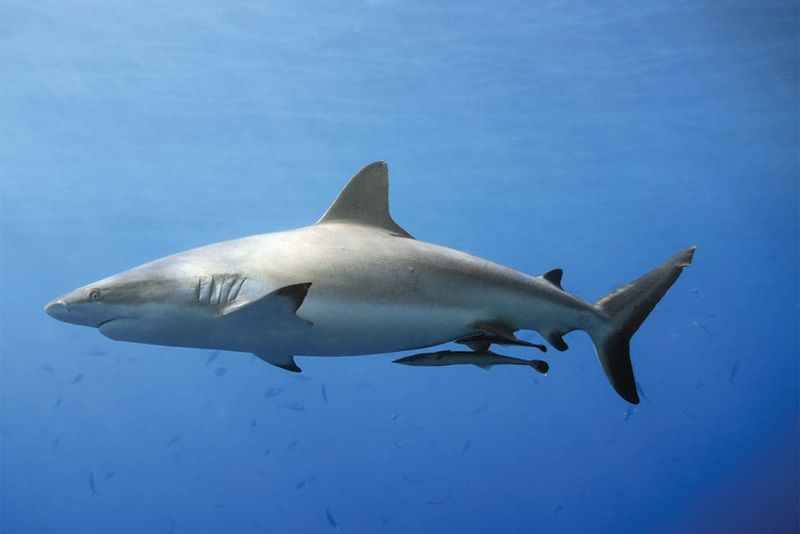
Last summer, I watched in awe as a blacktip shark launched itself completely out of the water while chasing a school of mullet near Galveston. These medium-sized predators are named for the distinctive black markings on their fin tips, creating an unmistakable silhouette when they’re near the surface.
Reaching lengths of about 5-6 feet, blacktips are among the most common sharks in Texas waters, especially during their spring and summer migrations. They prefer shallow coastal waters, making them visible from piers and beaches.
Despite their prevalence, blacktips are typically wary around humans. Their diet consists mainly of small fish, which explains their spectacular leaping behavior when hunting. The sight of several blacktips simultaneously breaching the water during a feeding frenzy is truly one of nature’s most exhilarating spectacles.
2. Bull Shark: The Freshwater Wanderer

“That’s definitely not a dolphin,” I muttered to myself, spotting the telltale broad snout of a bull shark cruising up the Brazos River nearly 20 miles inland. Few sharks command as much respect in Texas waters as the powerful bull shark, named for its short, blunt snout and stocky build.
What makes these sharks truly remarkable is their unique ability to tolerate freshwater. They’ve been spotted in rivers miles from the ocean, a rare trait among shark species. Growing up to 11 feet long and weighing over 500 pounds, bulls are powerfully built predators.
Their unpredictable nature and tendency to hunt in murky, shallow waters make them responsible for more attacks on humans than any other shark in Texas waters. I always give these magnificent but formidable creatures a wide berth when diving – their territorial behavior demands nothing less.
3. Bonnethead Shark: The Tiny Hammerhead Cousin
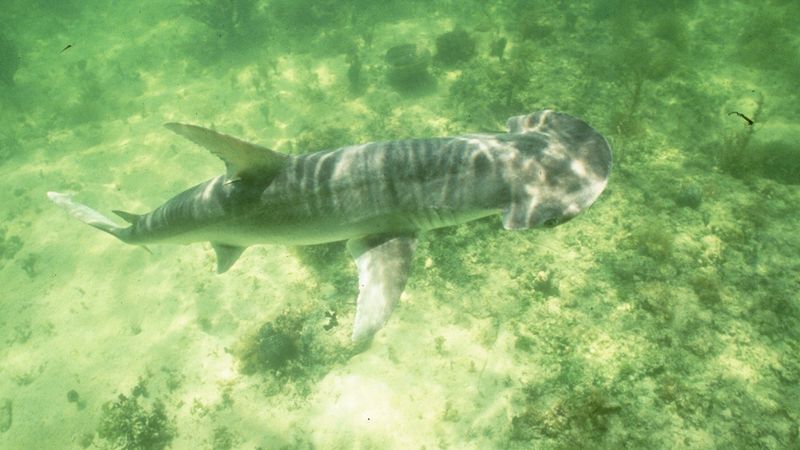
The first time I encountered a bonnethead shark, I mistook it for a baby hammerhead – an understandable error given their distinctive shovel-shaped heads. These diminutive sharks are the smallest members of the hammerhead family, rarely growing beyond 4 feet in length.
Bonnetheads have surprised scientists by being the only known omnivorous shark, munching on seagrass along with their preferred diet of crustaceans. You’ll spot them in shallow, grassy bays along the Texas coast, often swimming in groups – I once counted over twenty circling in a single bay near Corpus Christi!
Their small size and relatively docile nature make them one of the least threatening sharks you’ll encounter. While other sharks inspire fear, bonnetheads seem to evoke curiosity and even affection among beachgoers lucky enough to glimpse their unique silhouette gliding through shallow Texas waters.
4. Atlantic Sharpnose Shark: The Abundant Hunter
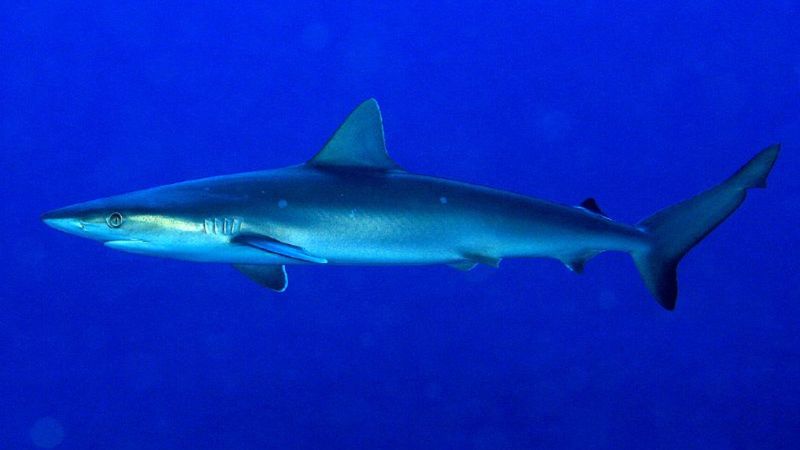
“Another sharpnose!” became our research team’s running joke during tagging expeditions – these sharks are everywhere along the Texas coast. Sporting a streamlined body with a pointed snout and distinctive white spots, Atlantic sharpnose sharks are among the most abundant shark species in the Gulf.
Growing to a modest 3-4 feet, these sharks compensate for their small size with impressive numbers. Their population thrives in Texas waters year-round, though they’re especially common during warmer months. I’ve watched them hunt with remarkable agility, darting through schools of small fish with precision that larger sharks can’t match.
Anglers frequently catch sharpnose sharks, making them an important recreational fishing species. Their relatively small size and abundance have helped their population remain stable despite fishing pressure – a marine success story in an era when many shark populations face serious decline.
5. Spinner Shark: The Twirling Torpedo
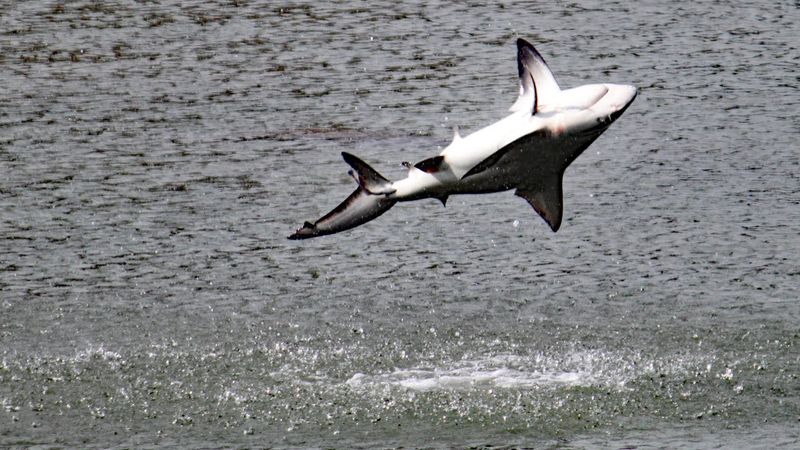
My camera barely captured the moment – a spinner shark rotating through the air like a marine ballerina before splashing back into the Gulf waters. Named for their spectacular spinning leaps, these energetic sharks put on some of the most impressive aerial displays in the animal kingdom.
Reaching lengths of 6-8 feet, spinners are slender, fast-swimming sharks with pointed snouts and black-tipped fins. They’re seasonal visitors to Texas waters, typically appearing during warmer months. Their hunting technique is as unique as it is effective – they speed vertically through fish schools, spinning to snap up prey, often continuing their rotation right out of the water.
Despite their intimidating acrobatics, spinner sharks rarely pose a threat to humans. They’re actually quite shy around people, quickly departing when swimmers approach. For wildlife photographers and shark enthusiasts, capturing a spinner’s aerial pirouette remains one of Texas coastal wildlife viewing’s greatest prizes.
6. Scalloped Hammerhead Shark: The Otherworldly Predator

The silhouette appeared so alien that my diving buddy grabbed my arm in shock – the unmistakable hammer-shaped head of a scalloped hammerhead gliding through the deeper waters off South Padre Island. With their bizarrely shaped heads and tall, pointed dorsal fins, these sharks look like visitors from another planet.
The scalloped hammerhead gets its name from the distinctive notches along the front edge of its head. These impressive sharks can reach lengths of 14 feet, though most in Texas waters are somewhat smaller. Their unique head shape isn’t just for show – it provides enhanced sensory capabilities, spacing their electroreceptors wider to better detect prey hidden in the sandy bottom.
Once common along the Texas coast, hammerhead populations have declined due to overfishing. Encountering one today is a rare privilege. Despite their intimidating appearance, they’re surprisingly timid around divers, making close encounters both safe and unforgettable.
7. Nurse Shark: The Lazy Lounger
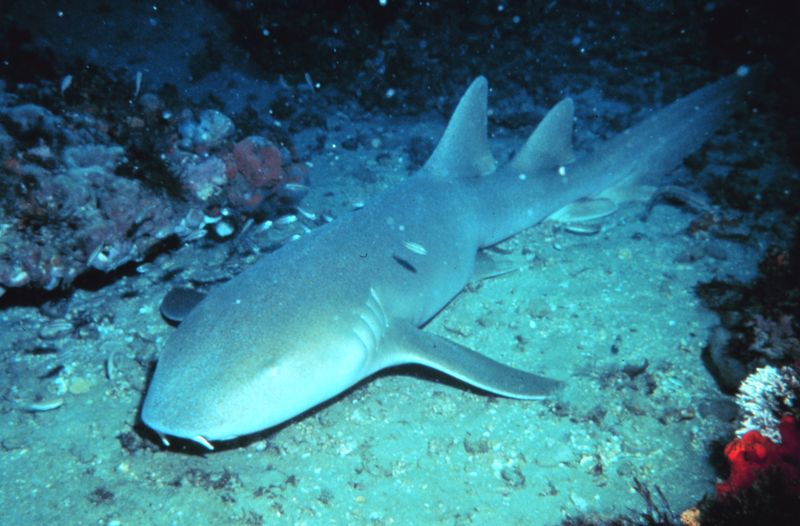
“Don’t worry about that one,” I told the panicked snorkeler pointing at the large shark resting under a rocky ledge near Port Aransas. “That’s just a nurse shark taking its afternoon nap.” Unlike their more active cousins, nurse sharks spend much of their time resting on the seafloor, their tawny-brown bodies blending perfectly with sandy bottoms.
Growing up to 10 feet long, these sharks might look intimidating, but they’re among the most docile shark species in Texas waters. Their mouths are filled with rows of small crushing teeth perfect for their diet of crustaceans, mollusks, and small fish – not human swimmers!
Nurse sharks are nocturnal hunters, becoming active after sunset when they use powerful suction to pull prey from crevices. During daylight hours, they’re typically found lounging in groups under ledges or in caves, making them a favorite subject for underwater photographers seeking a safe shark encounter.
8. Tiger Shark: The Garbage Disposal
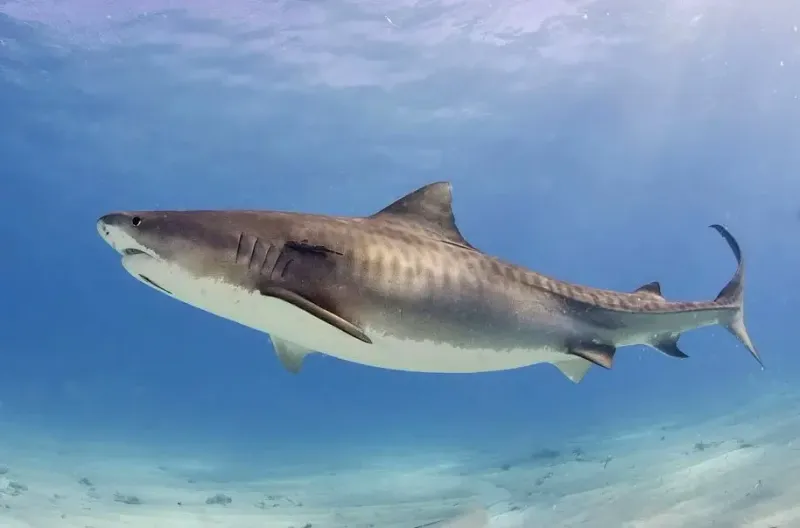
The massive shadow cruising beneath our research boat sent chills down my spine – the distinctive tiger-striped pattern of the ocean’s most notorious omnivore. Named for the dark vertical stripes that fade as they mature, tiger sharks are among the largest predators occasionally visiting Texas waters.
These impressive sharks can exceed 14 feet in length and have earned their reputation as the “garbage disposals” of the sea. Their diet includes virtually anything they encounter – fish, sea turtles, birds, and even inedible items like license plates and tires.
A colleague once found a cowboy boot inside a tiger shark’s stomach – a uniquely Texan meal! While relatively rare in Texas waters, they make seasonal appearances, especially around offshore structures. Their size and unpredictable feeding habits make them potentially dangerous to humans. However, actual encounters remain extremely uncommon, as these magnificent predators typically prefer offshore environments rather than crowded swimming beaches.
9. Lemon Shark: The Yellow-Hued Hunter

“That golden glow isn’t just the sunset,” I explained to my tour group as we spotted the yellowish shark patrolling the shallows near Matagorda Island. Lemon sharks get their name from their distinctive yellowish-brown coloration, which provides perfect camouflage over the sandy bottoms they prefer.
These substantial predators typically reach 10-12 feet in length and have a stocky build with two nearly equal-sized dorsal fins – a distinguishing feature among shark species. Texas waters serve as important nursery grounds for lemon sharks, with juveniles seeking safety in shallow, protected bays.
Despite their imposing size, lemon sharks have earned a reputation among researchers as the “labs” of the shark world due to their hardiness in captivity and relatively docile nature. They’re social creatures, sometimes forming loose groups – I’ve observed them hunting cooperatively, a behavior once thought impossible among sharks. Their intelligence and complex social structures continue to surprise scientists studying these golden Gulf predators.
10. Great Hammerhead Shark: The Ocean’s Heavyweight Champion
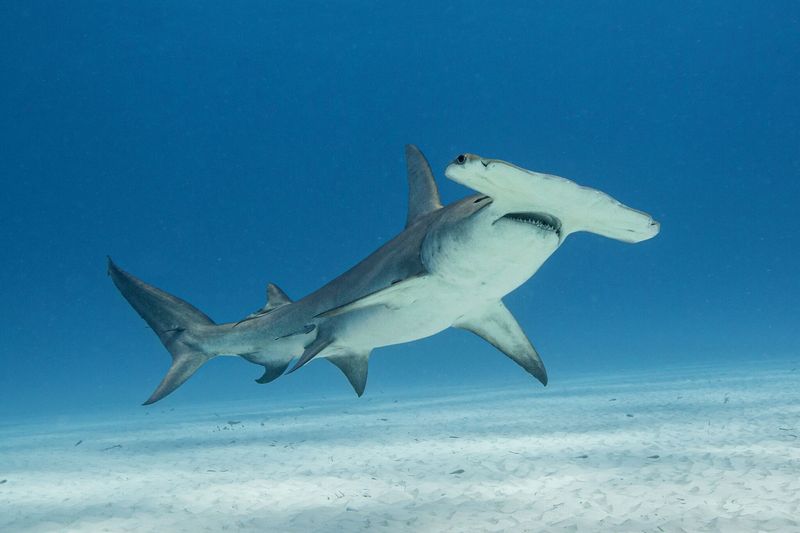
My heart nearly stopped when the enormous shadow appeared below our boat – the unmistakable T-shaped head of a great hammerhead, the largest and most impressive member of its family. Unlike its scalloped cousin, the great hammerhead’s head has a nearly straight front edge, giving it an even more otherworldly appearance.
These massive predators can reach an astonishing 20 feet in length and weigh over 1,000 pounds, though specimens in Texas waters typically run smaller. They’re seasonal visitors to our coast, preferring warmer months. Their hunting prowess is legendary – I’ve watched them use their hammer-shaped heads to pin stingrays to the seafloor before devouring them.
Great hammerheads are powerful swimmers capable of covering vast distances. Satellite tagging has revealed their ability to travel hundreds of miles between feeding grounds. Though rarely encountered by beachgoers due to their preference for deeper waters, spotting one of these magnificent giants from a boat represents the ultimate Texas shark-watching achievement.
